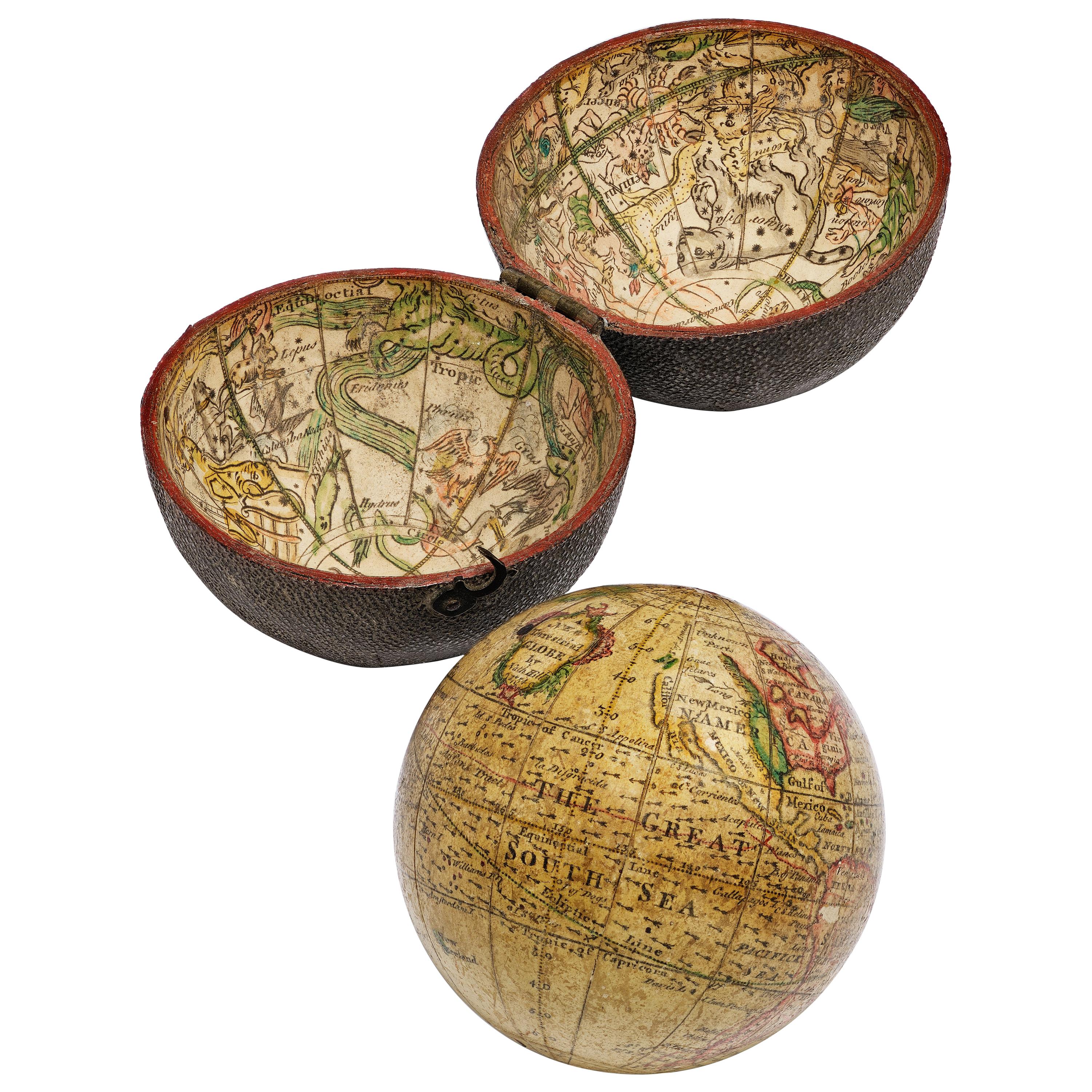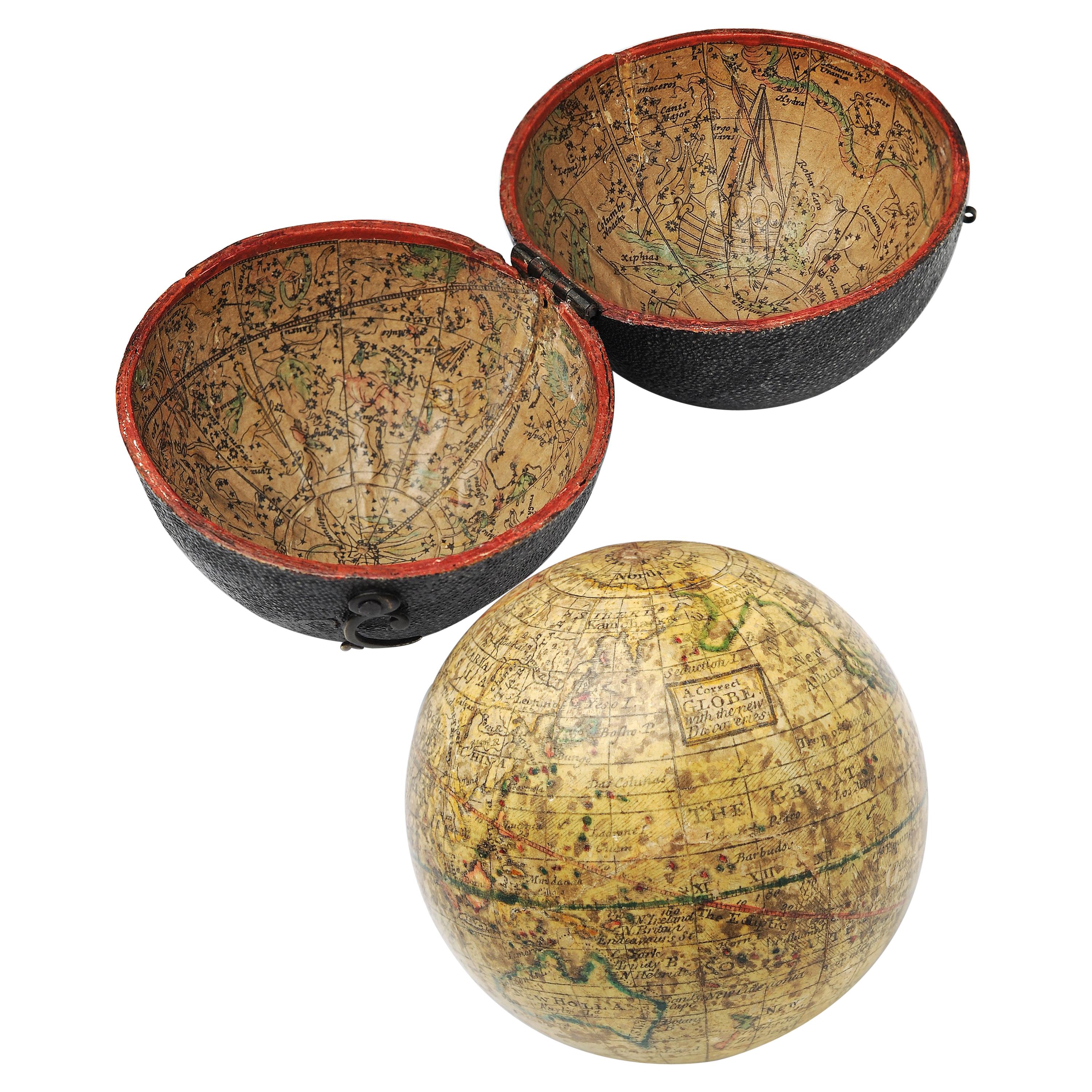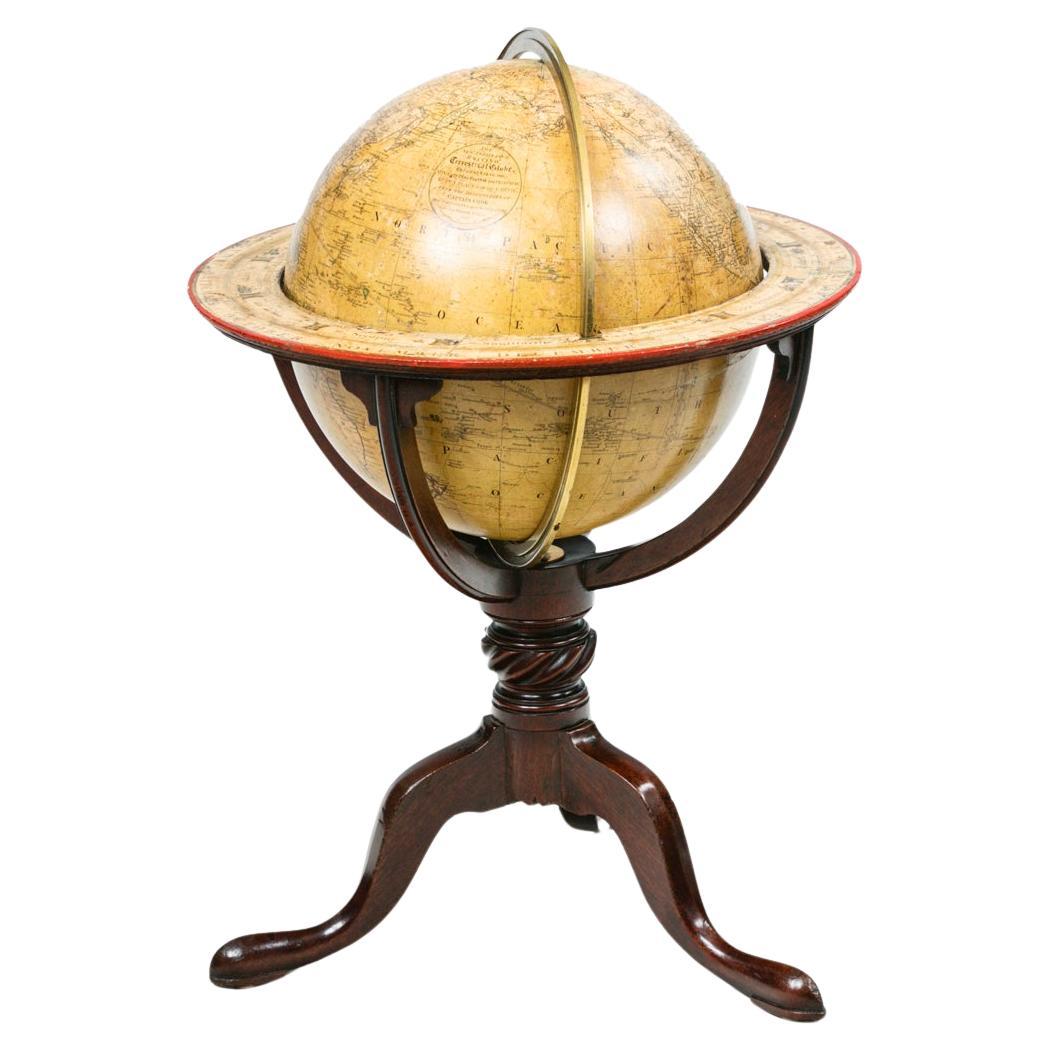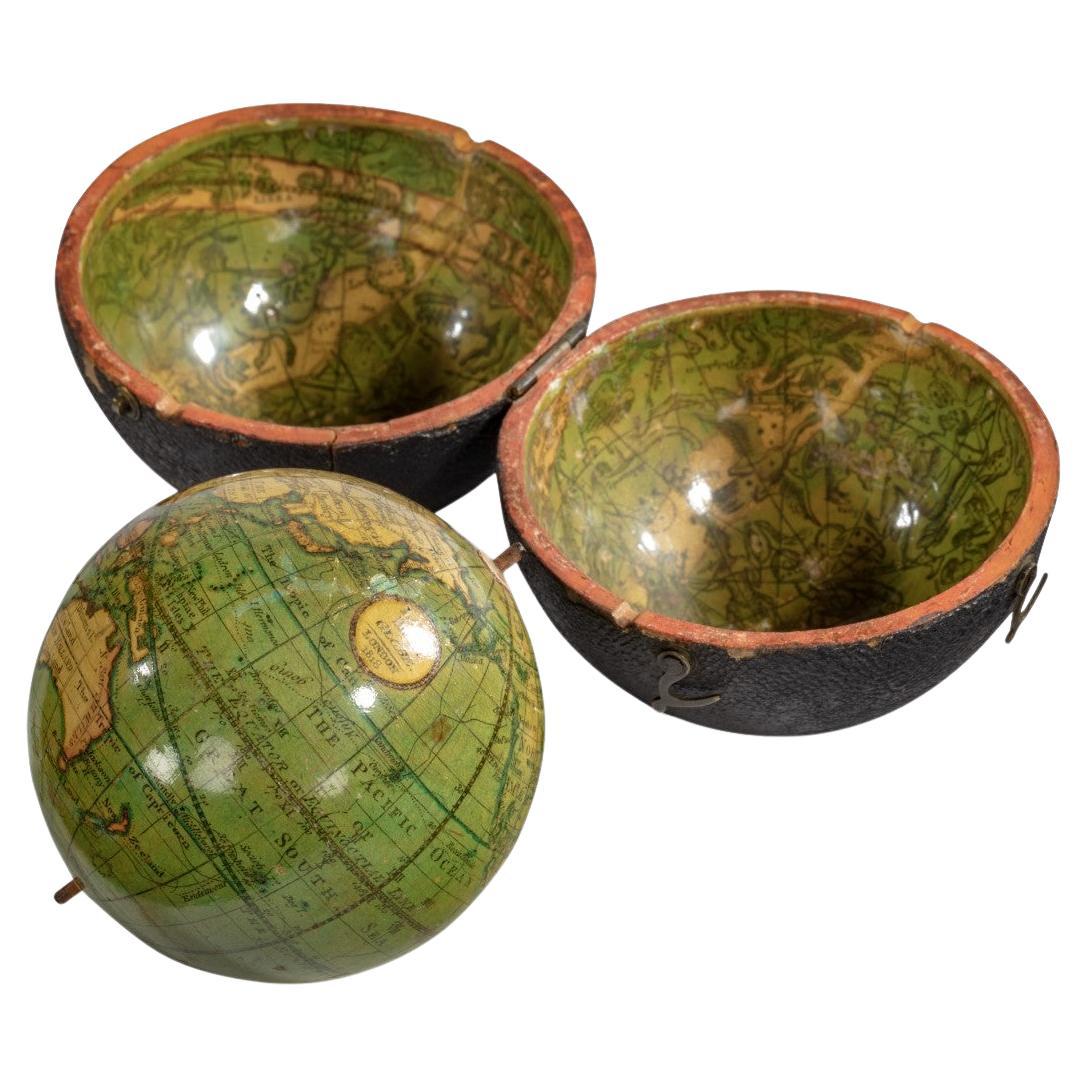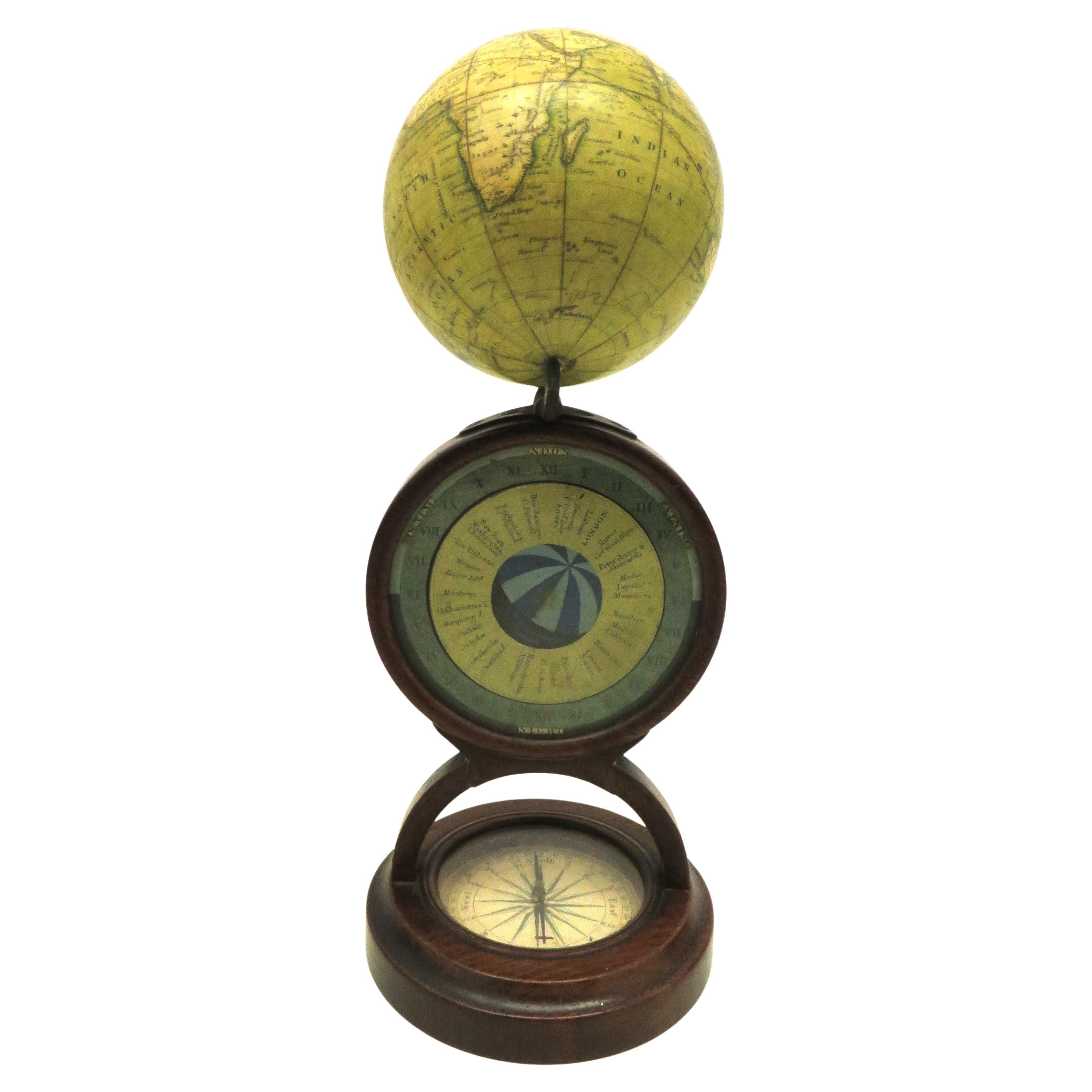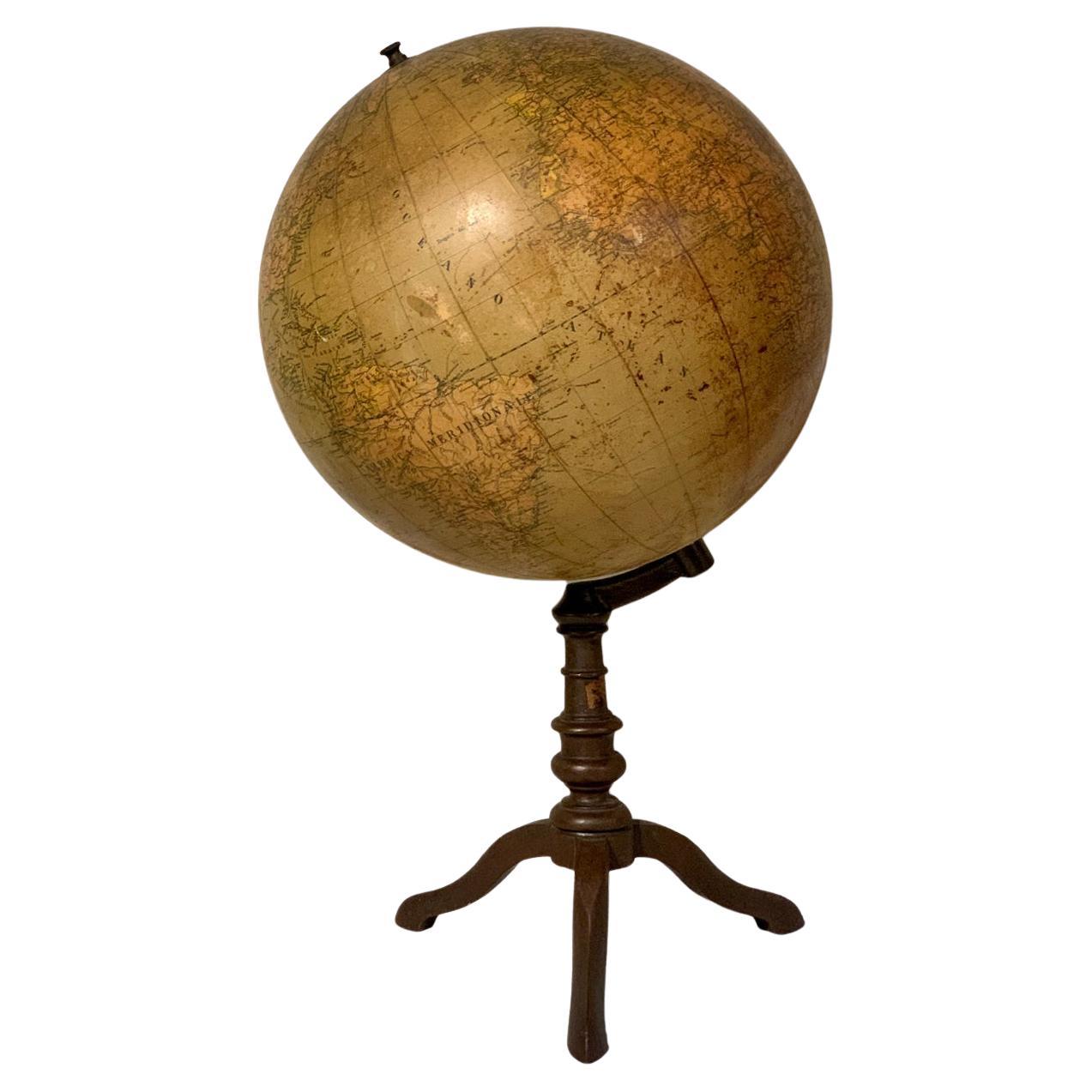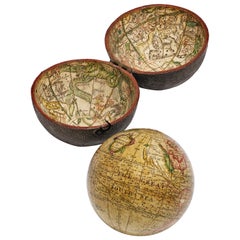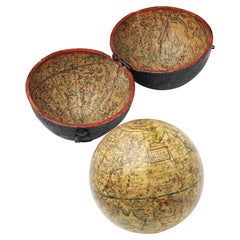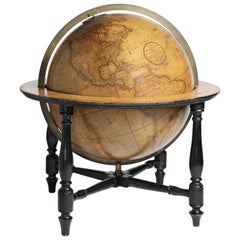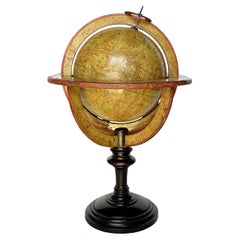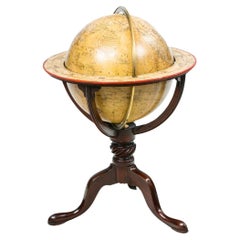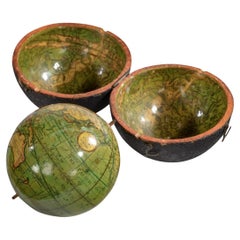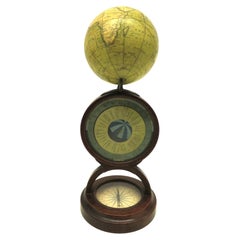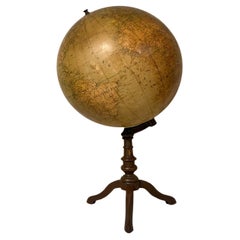Articoli simili a Pocket Globe, Nicholas Lane, London, post 1779
Caricamento del video
Vuoi altre immagini o video?
Richiedi altre immagini o video al venditore
1 di 22
Pocket Globe, Nicholas Lane, London, post 1779
12.000 €IVA inclusa
Informazioni sull’articolo
Pocket Globe
Nicholas Lane
London, post 1779
The globe is contained in its original case, which is covered in leather.
The sphere measures 2.75 in (6.9 cm) whereas the case measures 2.9 in (7.5 cm).
Weight: 0.28 lb (128 g).
State of conservation: almost excellent. It has some slight abrasions and a few signs of use. The case doesn't close completely.
The globe is made up of twelve printed paper gores aligned and glued to the sphere. On the Poles, two pins had been inserted, but these are now missing.
In the North Pacific Ocean, above the Tropic of Cancer, the globe bears a cartouche framed with small leafy branches. It contains the inscription:
A New
GLOBE
of the EARTH
by N. Lane
and, below the cartouche, there is:
1776 Prockter fc.
On the terrestrial globe, a large part of southern and central Africa is empty, and the Great Lakes Tanganyika and Victoria (which Europeans would begin to explore after 1858) are not marked. North America only bears the names of some British colonies. California is already depicted as a peninsula, but the northern territories of the continent are represented inaccurately: Alaska is barely described, and the northeastern coasts appear to be connected to Greenland. Australia, which bears the old name of New Holland (the new name would be introduced after 1824), is fully depicted, while Tasmania still appears as a peninsula. It was circumnavigated by Matthew Flinders in 1798.
In the South China Sea and the Indian Ocean, the directions of the monsoons are indicated. The Great Wall of China is also depicted on the map.
Some of the routes of the voyages of Anson and Cook are traced on the map. The pocket globe was likely created after the death of Captain Cook on February 14, 1779, as his place of death, Kealakekua Bay in the Hawaiian Islands, is marked on the map. It is indeed likely that the publication of the pocket globe took place in the period immediately following Cook's disappearance. By the time the two ships of his expedition returned to England in October 1780, the news of his demise had already been known for some time. (Nigel Rigby e Pieter van der Merwe, Captain Cook in the Pacific, London 2002, p. 61) This event surely would have sparked competition among publishers, leading to an accelerated update of maps and globes to be published.
The container is made up of two hemispheres covered in black leather and hinged together. Two hooks ensure its closure.
Inside the two hemispheres, the celestial vault is depicted, with stars and constellations indicated in both Latin and English. Many of them are represented by their corresponding mythological figures.
The current state of research does not allow for the reconstruction of the entire history of the Lane family. They were manufacturers of globes - especially pocket-sized ones - and the founder of the company in the 1770s was almost certainly Nicholas (perhaps a relative of John I, John II or James, all of whom were active in manufacturing scientific instruments for other entrepreneurs, starting from 1733); his son Thomas continued the business until at least the early decades of the nineteenth century. Then it is not clear which family members took over the management of the company. Sources have so far provided the names (George, John), but not the kinship relationships between them; the only certain fact is that the production of Lane branded globes continued until about the middle of the 19th century.
Bibliography:
P., Van der Krogt, Old Globes in the Netherlands, Utrecht 1984, pp. 180-182;
G. Clifton, Directory of British Scientific Instrument Makers 1550-1851, London 1995, s. v.;
E., Dekker, Globes at Greenwich, Oxford 1999, pp. 393-394;
Nigel Rigby e Pieter van der Merwe, Captain Cook in the Pacific, London 2002.
- Creatore:Nicholas Lane (Autore)
- Dimensioni:Altezza: 6,9 cm (2,72 in)Diametro: 6,9 cm (2,72 in)
- Stile:Altro (Del periodo)
- Materiali e tecniche:
- Luogo di origine:
- Periodo:1780-1789
- Data di produzione:Circa 1779
- Condizioni:Usura compatibile con l’età e l’utilizzo. It has some slight abrasions and a few signs of use. The case doesn't close completely.1200.
- Località del venditore:Milano, IT
- Numero di riferimento:1stDibs: LU4352238406382
Informazioni sul venditore
4,3
Venditore professionale selezionato
Ogni venditore supera rigorosi standard di autenticità e affidabilità
Fondazione nel 1860
Venditore 1stDibs dal 2018
21 vendite su 1stDibs
Associazioni
International Confederation of Art and Antique Dealers' Associations
- SpedizioneRecupero del preventivo…Spedizione da: Milano, Italia
- Politica di reso
Alcune parti di questa pagina sono state tradotte automaticamente. 1stDibs non può garantire che le traduzioni siano corrette. L’inglese è la lingua predefinita del sito.
Garanzia di autenticità
Nell’improbabile caso in cui si verifichi un problema con l’autenticità di un articolo, contattaci entro un anno per ottenere un rimborso completo. DettagliGaranzia di rimborso
Se il tuo articolo non corrisponde alla descrizione, è danneggiato durante il trasporto o non arriva, contattaci entro 7 giorni per un rimborso completo. DettagliAnnullamento entro 24 ore
Hai un periodo di tolleranza di 24 ore per annullare il tuo acquisto, senza necessità di fornire spiegazioni.Venditori professionali selezionati
I nostri venditori di livello internazionale devono aderire a rigorosi standard di servizio e qualità, garantendo l’integrità delle inserzioni.Garanzia miglior prezzo
Se scopri che un venditore ha pubblicato altrove lo stesso articolo a un prezzo più basso, applicheremo lo stesso prezzo.Consegna globale affidabile
La nostra rete di vettori leader del settore offre opzioni di spedizione specializzate in tutto il mondo, inclusa la consegna personalizzata.Altro da questo venditore
Mostra tuttoGlobo tascabile di Nathaniel Hill, Londra 1754
Nathaniel Hill
Mappamondo tascabile
Londra, 1754
Il globo è contenuto nella sua custodia originale, a sua volta ricoperta di pelle di squalo.
La vernice originale della sfera presen...
Categoria
Di antiquariato/d’epoca, Anni 1750, Inglese, Giorgio II, Globi terrestri
Materiali
Zigrino, Carta
Globo tascabile inglese, Londra, 1775-1798 circa
Di Herman Moll
Mappamondo tascabile
Londra, tra il 1775 e il 1798
Riedizione del mappamondo di Hermann Moll (1678-1732) datato 1719
Il globo è contenuto nella sua custodia originale, a sua volta ...
Categoria
Di antiquariato/d’epoca, Fine XVIII secolo, Inglese, Giorgio III, Globi ...
Materiali
Zigrino, Carta
Globo da 18 pollici, Cary, London, 1840
Di Cary’s
John & William Carys
Aggiornato da George & John Carys
Globo terrestre
Londra, 1840
lb 22 (kg 10)
Lievi abrasioni superficiali dovute all'uso. Una piccola crepa sul cerchio dell'or...
Categoria
Di antiquariato/d’epoca, Anni 1840, Inglese, Primo vittoriano, Globi ter...
Materiali
Carta, Legno
Celestial Table Globe, Charles-François Delamarche, Paris, 1791
Di Charles Francois Delamarche
Celestial table globe
Charles-François Delamarche
Paris, 1791
It measures: 17.13 in in height, Ø max 27.7 in; the sphere Ø 7.09 in
(h 43.5 cm x Ø max 27.7 cm; the sphere Ø 18 cm).
W...
Categoria
Di antiquariato/d’epoca, 1790s, French, Altro, Strumenti scientifici
Materiali
Metallo
Globo terrestre in miniatura Newton and Son London, post 1833, ante 1858
Di Newton and Son
Globo terrestre in miniatura
Newton & Son
Londra, post 1833, ante 1858
Carta, cartapesta, bronzo e Wood
Misura: diametro della sfera 2,95 pollici (7,6 cm); diametro della base in...
Categoria
Di antiquariato/d’epoca, Anni 1840, Inglese, Primo vittoriano, Mappe
Materiali
Bronzo
Globo da tavolo terrestre di Félix Delamarche, Parigi, 1821
Di Félix Delamarche
Globo terrestre da tavolo
Félix Delamarche
Parigi, 1821
Misura 20,47 pollici di altezza, Ø max 14,17 pollici; la sfera Ø 9,44 pollici (h 52 cm x Ø max 36,5 cm; la sfera Ø 24 cm).
...
Categoria
Di antiquariato/d’epoca, Anni 1820, Francese, Restaurazione, Strumenti s...
Materiali
Metallo
Ti potrebbe interessare anche
Globo terrestre britannico del XVIII secolo di W. & S. Jones, datato al 1800
Globo terrestre britannico del XVIII secolo da dodici pollici di W. & S. Jones, datato al 1800. Con descrizione che recita "Rappresentazione delle posizioni accurate dei principali l...
Categoria
Di antiquariato/d’epoca, XVIII secolo, Inglese, Globi terrestri
Materiali
Ottone
Globo tascabile di Regency Lane, datato 1818
Di Lane's
Mappamondo tascabile Regency Lane da 3 pollici e mezzo, datato 1818. Il globo terrestre con i mari in verde chiaro e le masse terrestri delineate in verde più scuro, è contenuto in u...
Categoria
Di antiquariato/d’epoca, Anni 1810, Inglese, Regency, Globi terrestri
Materiali
Legno
Un POCKET GLOBE in inglese con quadrante per i fusi orari
Di Newton and Son
NEWTON & SON (1840-61)
MAPPAMONDO TASCABILE INGLESE CON QUADRANTE PER I FUSI ORARI, 1835 CIRCA
Un supporto inedito per un mappamondo inglese dell'inizio del XIX secolo.
Mappamondo ...
Categoria
Di antiquariato/d’epoca, Anni 1830, Britannico, Altro, Globi terrestri
Materiali
Mogano
10.000 € Prezzo promozionale
20% in meno
Spedizione gratuita
Globo da tavolo dei primi del Novecento
Bellissimo mappamondo terrestre fisico e politico su base in bronzo e sfera in gesso con doppio movimento rotatorio.
Disegnato dal Prof. Guido Cora per G.B.Paravia Editori nella prim...
Categoria
Inizio XX secolo, Italiano, Modelli e miniature
Materiali
Bronzo
Raro globo terrestre da 12 pollici firmato Cary, London United Kingdom 1800.
Grande mappamondo terrestre da 12 pollici realizzato dai famosi fratelli Cary's, con una struttura in legno, un raffinato gesso levigato alla perfezione e gore di carta colorata. Il globo è sostenuto da una meridiana in ottone completamente graduata e l'anello orario si trova al Polo Nord. La tavola/anello dell'orizzonte, anch'essa rifinita con stampa calcografica e carta colorata, mostra i punti cardinali, i gradi di longitudine, i segni zodiacali, i giorni e i mesi dell'anno. Si erge su un supporto in legno ebanizzato con quattro gambe tornite collegate da un elemento incrociato che sostiene il globo. Il mappamondo è completato da 12 gore di carta stampate e colorate a mano. Un grande analemma nell'Oceano Pacifico. Completamente dettagliato. L'Australia è chiamata "New Holland" e l'Africa a sud dell'equatore è chiamata "Parts Unknown". John Cary e suo fratello William erano considerati i migliori costruttori di mappamondi inglesi del tardo periodo georgiano.
Cartiglio: "CARY'S NEW TERRESTRIAL GLOBE...
Categoria
Di antiquariato/d’epoca, Inizio XIX secolo, Inglese, Strumenti scientifici
Materiali
Ottone
Un piccolo globo terrestre di Newton, Londra 1820.
Sopra un piede rotondo che si innalza con un elemento centrale dal profilo mosso è collegato il mezzo meridiano in ottone, che regge alle estremità l'ascia metallica del piccolo glob...
Categoria
Di antiquariato/d’epoca, Inizio XIX secolo, Inglese, Globi terrestri
Materiali
Metallo, Ottone
